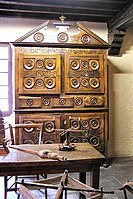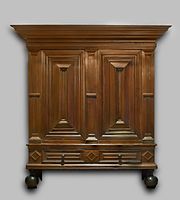Wardrobe
This articleneeds additional citations forverification.(December 2012) |
Awardrobe,also calledarmoireoralmirah,is a standingclosetused for storingclothes.The earliest wardrobe was achest,and it was not until some degree of luxury was attained in regalpalacesand thecastlesof powerful nobles that separate accommodation was provided for theapparelof the great. The name of wardrobe was then given to a room in which the wall-space was filled with closets and lockers, thedrawerbeing a comparatively modern invention.[citation needed]From these cupboards andlockersthe modern wardrobe, with its hanging spaces, slidingshelvesand drawers, evolved slowly.
Throughout the chronological changes in the form of the enclosure, it has more or less retained its preset function as a place to retain a king's robe. The word has gained coinage over successive generations as an independent store for among others, preserving precious items for a ruler like gold, well highlighted inKing Edward I's times. It is also a simple patio where clothes are hung from metal bars or tucked inside utility racks running from up to down. The modern wardrobe differs in one respect from the historical one for its triple partitioning: there are two linear compartments on either side with shelves as well as a middle space made up of hanging pegs and drawers, the latter being a latter-day addition, besides a clothes' press in the higher central space on level with a person's chest.
Additionally, an armoire is a wardrobe that is wider than a grown adult's arm span, while a wardrobe is smaller.
Etymology[edit]
The wordwardrobeappeared in the English language in the early 14th century. It originated from Old French wordswarderobe,wardereubeandgarderobe,in which "warder" meant "to keep, to guard" and "robe" meant "garment".[1]
History[edit]
In the United States, the wardrobe in its moveable form as anoak"hanging cupboard" dates back to the early 17th century. At that time it was an early export product from America to England, because English woodlands wereover-harvestedor reserved for the Navy. Consequently, the item was sometimes referred to as an oakley. For probably a hundred years, such pieces, massive and cumbrous in form, but often with well-carved fronts, were produced in moderate numbers; then the gradual diminution in the use ofoakforcabinet-making produced a change of fashion in favor of the more plentiful Americanwalnut.(The virgin American forests became successively Oak, then Maple with successive deforestation episodes.)
Walnutsucceeded oak as the favourite material for furniture, but hanging wardrobes in walnut appear to have been made very rarely, although clothes presses, with drawers and slidingtrays,were frequent.
During a large portion of the 18th century, thetallboywas much used for storing clothes.
Size[edit]
A common feature was to base future size on theeight small menmethod.[citation needed]A considered good size double wardrobe would thus be able to hold within its capacity, eight small men.
In the nineteenth century, the wardrobe began to develop into its modern form, with a hanging cupboard at each side, a press in the upper part of the central portion, and drawers below. As a rule, it was often ofmahogany,but assatinwoodand other previously scarce, fine-grained, foreign woods began to be obtainable in considerable quantities, many elaborately and even magnificently inlaid wardrobes were made.
WhereChippendaleand his school had carved, Sheraton,Hepplewhiteand their contemporaries achieved their effects by the artistic employment of deftly contrasted and highly polished woods.
The next to last step in the evolution of the wardrobe was taken when the central doors, which had previously enclosed merely the upper part, were carried to the floor, covering the drawers as well as the sliding shelves, and were often fitted with mirrors.
In theUnited Kingdom,a more affluent option is custom-fitted wardrobes, which are built around the size and shape of the room.
Frankfurt cabinet[edit]

The Frankfurt cabinet is a two-door, baroque cupboard or wardrobe from the city ofFrankfurtwith a clear architectural structure system. These were made from spruce with a walnut veneer or solid oak. Unveneered examples made of pine are usually contemporary replicas. Thanks to their design, all cabinets can be dismantled into several individual parts and reassembled in just a few steps, without any tools, but require two people.
The cabinets were demanded as masterpieces of Frankfurt carpentry, but could also have been commissioned by patrician families. The original meaning was to store household linen and clothes; the size was intended to illustrate the owner family's existing linen supply. Historical examples were and are more often used as filing cabinets, e.g. used in the operating rooms of the Frankfurt City Hall or in banks.
Kas style[edit]
Kas, kast, or kasten (pronounced kaz) is a massive cupboard or wardrobe of Dutch origin similar to an armoire that was popular in the Netherlands and America in the 17th & 18th centuries. It was fitted with shelves and drawers used to store linen, clothing, and other valuables and locked by key. They were status symbols and family heirlooms in the Low Countries and importedluxury goodsto the American colonies. As such they were often made of quality wood such ascherry,rosewood and ebony that were panelled, carved or painted.[2][3]
-
Intricately carved French Oakley styletallboywith under-cabinet instead of achest of drawers
-
A modern fitted wardrobe
-
Kas, early 19th century,Brooklyn Museum(New York City)
See also[edit]
- Cabinetry
- Closet
- Encoignure
- Hoosier cabinet
- Shoe rack
- Tansu(Japanese)
References[edit]
- ^Harper, Douglas."wardrobe".Online Etymology Dictionary.
- ^Segal, Troy."Kas or Kast Wardrobe Example".www.about.com.About.com.Retrieved11 July2014.
- ^"Kas".Brooklyn Museum.Retrieved11 July2014.
External links[edit]
- American kasten: the Dutch-style cupboards of New York state and New Jersey, 1650–1800,an exhibition catalog from The Metropolitan Museum of Art Libraries (fully available online as PDF doucment), containing materials on wardrobes.




